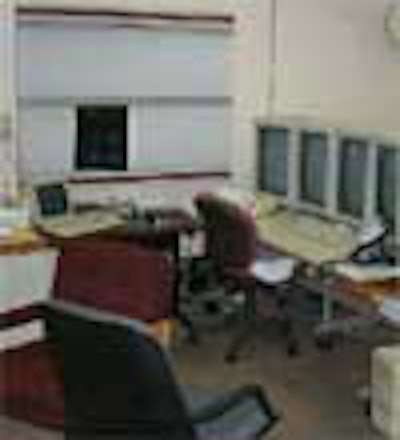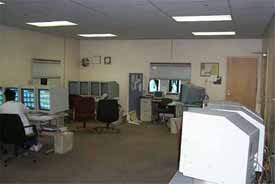
One might think that early PACS adopters would be at the forefront of soft-copy reading room design, but they haven't been. In fact, reading rooms in most pioneering PACS facilities haven't changed much since they were built for interpreting films. Now, with evidence that overlit and uncomfortable environments can cause fatigue and reading errors, researchers are coming to believe that radiologists' sighs matter.
Great effort has gone into designing PACS workstations, networks, servers, and system architecture, according to Dr. Eliot Siegel, a radiologist with the Baltimore VA Medical Center. However, the task of adapting the physical reading environment to take advantage of PACS technology has received almost no attention, he said. Siegel talked about the importance of reading room design at the June Symposium of Computer Applications in Radiology (SCAR) in Philadelphia.
In a detailed poll of 10 geographically diverse facilities where PACS networks had been operating the longest, Siegel and colleagues found that few, if any, environmental changes had been made to accommodate soft-copy interpretation, despite an apparent need for them.

Most soft-copy images are read in rooms designed for film interpretation. Photo courtesy of Baltimore VA Medical Center
"A number of studies performed at our facilities and others suggest that the environmental conditions required for soft-copy interpretation are very different from those of a conventional department, in a number of important ways," he said.
All other factors being equal, radiologists tend to get more fatigued earlier in a filmless environment than in a film-based one. In the course of a 90-minute reading session -- the mean reported by survey respondents -- fatigue could increase significantly if human factors are suboptimal, he said.
"One and a half hours is comparable to the length of a feature movie," he said. "In my opinion, one should have at least as comfortable seating, lighting, ventilation, and noise control as one would in a movie theater."
Survey respondents cited room lighting as the single most important factor contributing to fatigue.
"What we've found in previous studies is that the amount of fatigue that radiologists experience increases significantly as the amount of ambient room light increases," he said. However, reading time did not increase as fatigue levels rose.
An earlier study concluded that while no radiologists reported high fatigue after reading in rooms with the lights turned off, nearly half reported high fatigue levels with room lighting at full strength, Siegel noted in follow-up information supplied for this story.
The study also found that soft-copy reading was somewhat more accurate when ambient light was minimized, and recommended low ambient light levels with individual light fixtures in workstations that could be adjusted and used to perform other tasks.
Survey respondents complained of fixed, direct room lighting that couldn't be adjusted. While half reported that their reading rooms had dimmer switches to adjust lighting for the entire room, most couldn't adjust the lighting at their work areas.
Respondents called monitor brightness the second most important factor. An earlier study on the subject concluded that inadequate monitor brightness results in increased reading time, decreased accuracy, and increased radiologist fatigue, Siegel later reported.
Many survey participants recommended that reading rooms be compartmentalized into individually controlled workstations -- or larger rooms divided into smaller ones. While large, centralized rooms were once necessary to facilitate the delivery of films, Siegel said, networked image delivery makes them unnecessary. The growth of telephone and e-mail consultations has also reduced the need for personal contact, making individually controlled workstations possible.
Especially in academic environments, participants value the interaction with colleagues that comes from working in a larger room, Siegel said, making the walled-off workstation a two-edged sword.
Respondents also wanted comfortable chairs. Most said their own chairs had lumbar support, but lacked other features they wanted: armrests and the ability to recline. Chairs with wheels and the ability to swivel made it easier to move quickly to other workstations, they said -- to consult with colleagues, or access the hospital or radiology information systems (HIS/RIS) for example.
Apparently, just zooming around the room in their chairs wasn't enough either. Several respondents wanted HIS/RIS integrated into their workstations, eliminating the need to change locations to look up patient records or make a phone call. Ideally, telephone systems, e-mail, desktop office applications, and environmental controls should all be integrated into the same workstations, Siegel later recommended.
A few facilities had reading room walls that had been painted darker to reduce glare. Some had turned down the room lights. But overall, the researchers found room design mostly unchanged from film-reading days.
"Reading rooms did not differ significantly from earlier designs," Siegel said. "This paradigm is not adequate."
But the survey was just a beginning, he said, with plenty of work ahead. For example, more study is needed to gauge the precise effects of ergonomics on accuracy and output. Another survey will also poll residents and fellows to see if their needs differ from radiologists as a whole -- for example, in the amount of time needed to interact with colleagues, he said.
PACS vendors will also be polled to look at how and to what extent they are incorporating human factors into their workstation designs. And the researchers plan to look at challenging workstation environments outside radiology to learn what works in these locations. The Baltimore VA team has received grant funding to continue its research into reading room design, Siegel said.
By Eric Barnes
AuntMinnie.com staff writer
August 29, 2000
Let AuntMinnie.com know what you think about this story.
Copyright © 2000 AuntMinnie.com

















